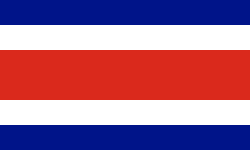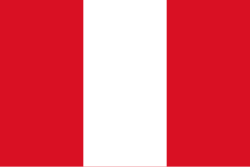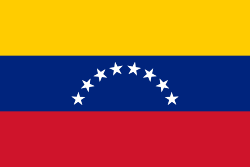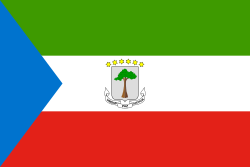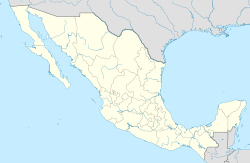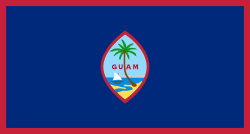Guadalajara (Mexiko)
| Guadalajara | |
|---|---|
| Poloha | |
| Souřadnice | 20°40′36″ s. š., 103°20′51″ z. d. |
| Nadmořská výška | 1 566 m n. m. |
| Stát | |
| Federální stát | Jalisco |
| Rozloha a obyvatelstvo | |
| Rozloha | 151 km² |
| Počet obyvatel | 1 495 189 (2010) |
| Hustota zalidnění | 9 901,9 obyv./km² |
| Správa | |
| Starosta | Enrique Alfaro Ramírez |
| Vznik | 1542 |
| Zakladatel | Cristóbal de Oñate |
| Oficiální web | portal |
| Některá data mohou pocházet z datové položky. | |
Guadalajara je velkoměsto v západní části Mexika, hlavní město státu Jalisco a druhé největší město v Mexiku vůbec. Žije zde přibližně 1,46 milionu obyvatel. Včetně aglomerace dosahuje přibližně 4,5 milionu obyvatel.
Město je pojmenováno podle španělského města Guadalajara. Název pochází z arabštiny a znamená „řeka tekoucí mezi skalami“. Ve městě se nachází hospic Cabañas – jedna z mexických památek figurujících na seznamu kulturního dědictví UNESCO.
Sport
Ve městě sídlí několik profesionálních fotbalových klubů. Z nich nejslavnější je CD Guadalajara.
Významní rodáci
- Pepe Guízar (1906–1980), hudební skladatel, autor populární mexické písně Guadalajara, která opěvuje krásy tohoto města
- Gael García Bernal (* 1978) – herec
- Lorena Ochoa (* 1981) – golfistka
- Sergio Pérez „Checo“(* 1990) – současný pilot Formule 1 ,jezdec Oracle Red Bull Racing a s číslem 11
- Javier Hernández Balcázar (* 1988) – fotbalista Manchester United FC
- Santos Saúl „Canelo“ Álvarez Barragán (* 1990) – boxer, střední váha, několikanásobný světový šampion, WBA, WBC, WBO, IBF
Partnerská města
 Alajuela, Kostarika
Alajuela, Kostarika Albuquerque, USA
Albuquerque, USA Arequipa, Peru
Arequipa, Peru Caracas, Venezuela
Caracas, Venezuela Cebu City, Filipíny
Cebu City, Filipíny Ceuta, Španělsko
Ceuta, Španělsko Cigales, Španělsko
Cigales, Španělsko Cleveland, USA
Cleveland, USA Curitiba, Brazílie
Curitiba, Brazílie Tedžon, Jižní Korea
Tedžon, Jižní Korea Downey, USA
Downey, USA Guadalajara, Španělsko
Guadalajara, Španělsko Hagåtña, Guam
Hagåtña, Guam Kansas City, USA
Kansas City, USA Kingston, Jamajka
Kingston, Jamajka Krakov, Polsko
Krakov, Polsko Kjóto, Japonsko
Kjóto, Japonsko Lansing, USA
Lansing, USA Magdalena de Kino, Mexiko
Magdalena de Kino, Mexiko Malabo, Rovníková Guinea
Malabo, Rovníková Guinea Milán, Itálie
Milán, Itálie Nochistlán, Mexiko
Nochistlán, Mexiko Oñati, Španělsko
Oñati, Španělsko Ciudad de Panamá, Panama
Ciudad de Panamá, Panama Portland , Oregon, USA
Portland , Oregon, USA St. Louis, Missouri, USA
St. Louis, Missouri, USA San Antonio, Texas, USA
San Antonio, Texas, USA San José, Kostarika
San José, Kostarika San Salvador, Salvador
San Salvador, Salvador Santo Domingo, Dominikánská republika
Santo Domingo, Dominikánská republika Sevilla, Španělsko
Sevilla, Španělsko Tegucigalpa, Honduras
Tegucigalpa, Honduras Tucson, Arizona, USA
Tucson, Arizona, USA Wroclaw, Polsko
Wroclaw, Polsko Sia-men, Čína
Sia-men, Čína
Odkaz v kultuře
V Guadalajaře byla odehrána základní skupina mistrovství světa ve fotbale v roce 1970. Tým Československa byl vyřazen v základní fázi po výsledcích 1–4 s Brazílií, kdy Ivo Viktor taktak nedostal gól Pelého z poloviny hřiště. Další utkání s Rumunskem skončilo 1–2 a poslední s Anglií 0–1. Jediným střelcem reprezentace byl Laco Petráš. Neúspěch měl v Československu hořkou dohru v aféře Puma/Adidas.[1]
V Guadalajaře byla odehrána i skupina D mistrovství světa ve fotbale v roce 1986. Tam se však československá reprezentace nekvalifikovala. Trvalým ohlasem neúspěchu zůstává píseň Michala Tučného
Všichni jsou už v Mexiku
Buenos Dias já taky jdu
Aspoň si poslechnu pěknou muziku,
co se hraje v Mexiku...
Odkazy
Reference
- ↑ JAKOUBEK, Jiří. Legendární Ivo Viktor: Strana si na nás našla bič. Kopačky. Lidové noviny [online]. 2010-7-29 [cit. 2021-11-11]. Dostupné online.
Externí odkazy
 Obrázky, zvuky či videa k tématu Guadalajara na Wikimedia Commons
Obrázky, zvuky či videa k tématu Guadalajara na Wikimedia Commons  Galerie Guadalajara na Wikimedia Commons
Galerie Guadalajara na Wikimedia Commons- Portál města Guadalajara (španělsky)
Média použitá na této stránce
Flag of Jamaica. “The sunshine, the land is green, and the people are strong and bold” is the symbolism of the colours of the flag. GOLD represents the natural wealth and beauty of sunlight; GREEN represents hope and agricultural resources; BLACK represents the strength and creativity of the people. The original symbolism, however, was "Hardships there are, but the land is green, and the sun shineth", where BLACK represented the hardships being faced.
The flag of the Dominican Republic has a centered white cross that extends to the edges. This emblem is similar to the flag design and shows a bible, a cross of gold and 6 Dominican flags. There are branches of olive and palm around the shield and above on the ribbon is the motto "Dios,Patria!, Libertad" ("God, Country, Freedom") and to amiable freedom. The blue is said to stand for liberty, red for the fire and blood of the independence struggle and the white cross symbolized that God has not forgotten his people. "Republica Dominicana". The Dominican flag was designed by Juan Pablo Duarte, father of the national Independence of Dominican Republic. The first dominican flag was sewn by a young lady named Concepción Bona, who lived across the street of El Baluarte, monument where the patriots gathered to fight for the independence, the night of February 27th, 1844. Concepción Bona was helped by her first cousin María de Jesús Pina.
The flag of the Dominican Republic has a centered white cross that extends to the edges. This emblem is similar to the flag design and shows a bible, a cross of gold and 6 Dominican flags. There are branches of olive and palm around the shield and above on the ribbon is the motto "Dios,Patria!, Libertad" ("God, Country, Freedom") and to amiable freedom. The blue is said to stand for liberty, red for the fire and blood of the independence struggle and the white cross symbolized that God has not forgotten his people. "Republica Dominicana". The Dominican flag was designed by Juan Pablo Duarte, father of the national Independence of Dominican Republic. The first dominican flag was sewn by a young lady named Concepción Bona, who lived across the street of El Baluarte, monument where the patriots gathered to fight for the independence, the night of February 27th, 1844. Concepción Bona was helped by her first cousin María de Jesús Pina.
Note: The color selected is «turquoise blue» (the color mentioned in the decree), as defined by Pantone.
The flag of Guam, courtesy an e-mail from the author of xrmap. Modifications by Denelson83.
Autor: Marrovi, Licence: CC BY 3.0
Municipal flag of Guadalajara, Jalisco




